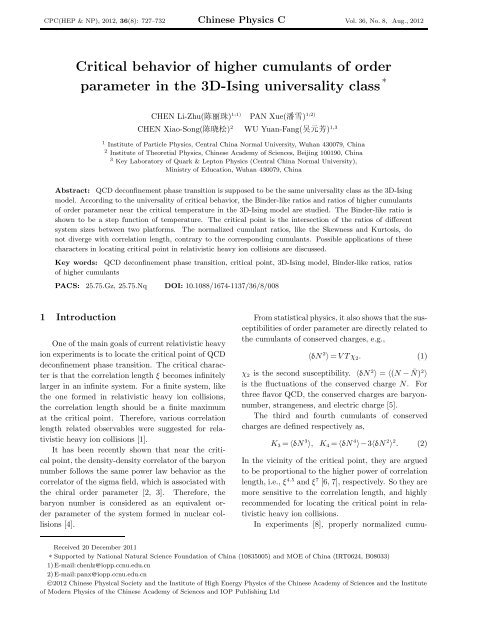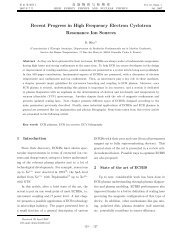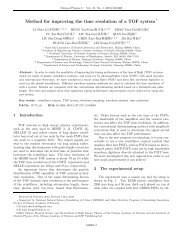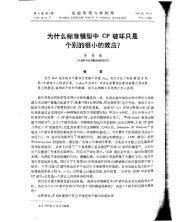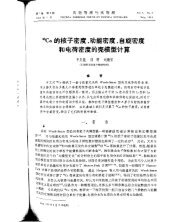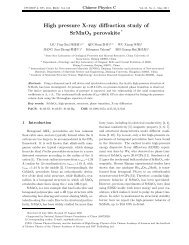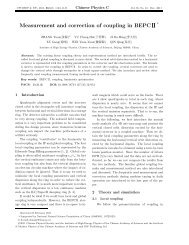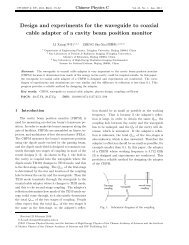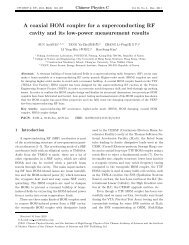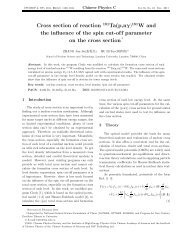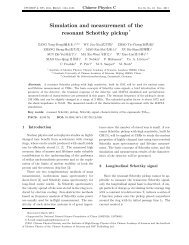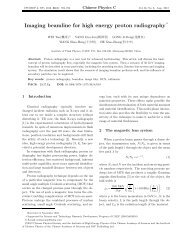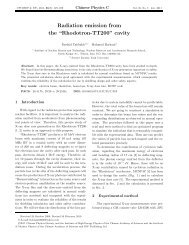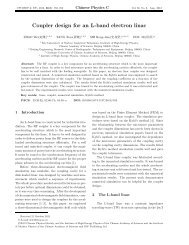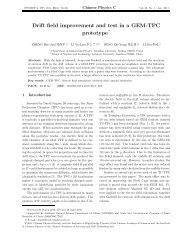Critical behavior of higher cumulants of order parameter in the 3D ...
Critical behavior of higher cumulants of order parameter in the 3D ...
Critical behavior of higher cumulants of order parameter in the 3D ...
- No tags were found...
You also want an ePaper? Increase the reach of your titles
YUMPU automatically turns print PDFs into web optimized ePapers that Google loves.
CPC(HEP & NP), 2012, 36(8): 727–732 Ch<strong>in</strong>ese Physics C Vol. 36, No. 8, Aug., 2012<strong>Critical</strong> <strong>behavior</strong> <strong>of</strong> <strong>higher</strong> <strong>cumulants</strong> <strong>of</strong> <strong>order</strong><strong>parameter</strong> <strong>in</strong> <strong>the</strong> <strong>3D</strong>-Is<strong>in</strong>g universality class *CHEN Li-Zhu() 1;1) PAN Xue() 1;2)CHEN Xiao-Song() 2 WU Yuan-Fang() 1,31 Institute <strong>of</strong> Particle Physics, Central Ch<strong>in</strong>a Normal University, Wuhan 430079, Ch<strong>in</strong>a2 Institute <strong>of</strong> Theoretial Physics, Ch<strong>in</strong>ese Academy <strong>of</strong> Sciences, Beij<strong>in</strong>g 100190, Ch<strong>in</strong>a3 Key Laboratory <strong>of</strong> Quark & Lepton Physics (Central Ch<strong>in</strong>a Normal University),M<strong>in</strong>istry <strong>of</strong> Education, Wuhan 430079, Ch<strong>in</strong>aAbstract: QCD deconf<strong>in</strong>ement phase transition is supposed to be <strong>the</strong> same universality class as <strong>the</strong> <strong>3D</strong>-Is<strong>in</strong>gmodel. Accord<strong>in</strong>g to <strong>the</strong> universality <strong>of</strong> critical <strong>behavior</strong>, <strong>the</strong> B<strong>in</strong>der-like ratios and ratios <strong>of</strong> <strong>higher</strong> <strong>cumulants</strong><strong>of</strong> <strong>order</strong> <strong>parameter</strong> near <strong>the</strong> critical temperature <strong>in</strong> <strong>the</strong> <strong>3D</strong>-Is<strong>in</strong>g model are studied. The B<strong>in</strong>der-like ratio isshown to be a step function <strong>of</strong> temperature. The critical po<strong>in</strong>t is <strong>the</strong> <strong>in</strong>tersection <strong>of</strong> <strong>the</strong> ratios <strong>of</strong> differentsystem sizes between two platforms. The normalized cumulant ratios, like <strong>the</strong> Skewness and Kurtosis, donot diverge with correlation length, contrary to <strong>the</strong> correspond<strong>in</strong>g <strong>cumulants</strong>. Possible applications <strong>of</strong> <strong>the</strong>secharacters <strong>in</strong> locat<strong>in</strong>g critical po<strong>in</strong>t <strong>in</strong> relativistic heavy ion collisions are discussed.Key words: QCD deconf<strong>in</strong>ement phase transition, critical po<strong>in</strong>t, <strong>3D</strong>-Is<strong>in</strong>g model, B<strong>in</strong>der-like ratios, ratios<strong>of</strong> <strong>higher</strong> <strong>cumulants</strong>PACS: 25.75.Gz, 25.75.Nq DOI: 10.1088/1674-1137/36/8/0081 IntroductionOne <strong>of</strong> <strong>the</strong> ma<strong>in</strong> goals <strong>of</strong> current relativistic heavyion experiments is to locate <strong>the</strong> critical po<strong>in</strong>t <strong>of</strong> QCDdeconf<strong>in</strong>ement phase transition. The critical characteris that <strong>the</strong> correlation length ξ becomes <strong>in</strong>f<strong>in</strong>itelylarger <strong>in</strong> an <strong>in</strong>f<strong>in</strong>ite system. For a f<strong>in</strong>ite system, like<strong>the</strong> one formed <strong>in</strong> relativistic heavy ion collisions,<strong>the</strong> correlation length should be a f<strong>in</strong>ite maximumat <strong>the</strong> critical po<strong>in</strong>t. Therefore, various correlationlength related observables were suggested for relativisticheavy ion collisions [1].It has been recently shown that near <strong>the</strong> criticalpo<strong>in</strong>t, <strong>the</strong> density-density correlator <strong>of</strong> <strong>the</strong> baryonnumber follows <strong>the</strong> same power law <strong>behavior</strong> as <strong>the</strong>correlator <strong>of</strong> <strong>the</strong> sigma field, which is associated with<strong>the</strong> chiral <strong>order</strong> <strong>parameter</strong> [2, 3]. Therefore, <strong>the</strong>baryon number is considered as an equivalent <strong>order</strong><strong>parameter</strong> <strong>of</strong> <strong>the</strong> system formed <strong>in</strong> nuclear collisions[4].From statistical physics, it also shows that <strong>the</strong> susceptibilities<strong>of</strong> <strong>order</strong> <strong>parameter</strong> are directly related to<strong>the</strong> <strong>cumulants</strong> <strong>of</strong> conserved charges, e.g.,〈δN 2 〉 = V T χ 2 . (1)χ 2 is <strong>the</strong> second susceptibility. 〈δN 2 〉 = 〈(N − ¯N) 2 〉is <strong>the</strong> fluctuations <strong>of</strong> <strong>the</strong> conserved charge N. Forthree flavor QCD, <strong>the</strong> conserved charges are baryonnumber,strangeness, and electric charge [5].The third and fourth <strong>cumulants</strong> <strong>of</strong> conservedcharges are def<strong>in</strong>ed respectively as,K 3 = 〈δN 3 〉, K 4 = 〈δN 4 〉−3〈δN 2 〉 2 . (2)In <strong>the</strong> vic<strong>in</strong>ity <strong>of</strong> <strong>the</strong> critical po<strong>in</strong>t, <strong>the</strong>y are arguedto be proportional to <strong>the</strong> <strong>higher</strong> power <strong>of</strong> correlationlength, i.e., ξ 4.5 and ξ 7 [6, 7], respectively. So <strong>the</strong>y aremore sensitive to <strong>the</strong> correlation length, and highlyrecommended for locat<strong>in</strong>g <strong>the</strong> critical po<strong>in</strong>t <strong>in</strong> relativisticheavy ion collisions.In experiments [8], properly normalized cumu-Received 20 December 2011* Supported by National Natural Science Foundation <strong>of</strong> Ch<strong>in</strong>a (10835005) and MOE <strong>of</strong> Ch<strong>in</strong>a (IRT0624, B08033)1) E-mail: chenlz@iopp.ccnu.edu.cn2) E-mail: panx@iopp.ccnu.edu.cn©2012 Ch<strong>in</strong>ese Physical Society and <strong>the</strong> Institute <strong>of</strong> High Energy Physics <strong>of</strong> <strong>the</strong> Ch<strong>in</strong>ese Academy <strong>of</strong> Sciences and <strong>the</strong> Institute<strong>of</strong> Modern Physics <strong>of</strong> <strong>the</strong> Ch<strong>in</strong>ese Academy <strong>of</strong> Sciences and IOP Publish<strong>in</strong>g Ltd
728 Ch<strong>in</strong>ese Physics C (HEP & NP) Vol. 36lants, i.e., Skewness and Kurtosis,K 3 /K 3/22 = 〈δN 3 〉〈δN 2 〉 , K 4/K 2 = 〈δN 4 〉3/2 2−3, (3)〈δN 2 〉2were actually presented. As <strong>the</strong> second cumulant <strong>in</strong>denom<strong>in</strong>ator is also proportional to a certa<strong>in</strong> power <strong>of</strong>correlation length [9], whe<strong>the</strong>r such normalized skewnessand kurtosis still diverge with <strong>the</strong> correlationlength is not clear from <strong>the</strong> <strong>the</strong>oretical po<strong>in</strong>t <strong>of</strong> view.From <strong>the</strong> <strong>the</strong>oretical side, <strong>the</strong> ratios <strong>of</strong> <strong>higher</strong><strong>order</strong><strong>cumulants</strong> to <strong>the</strong> second one, e.g.,R 3,2 = K 3K 2= 〈δN 3 〉〈δN 2 〉 ,R 4,2 = K 4K 2= 〈δN 4 〉〈δN 2 〉 −3〈δN 2 〉,(4)are estimated [10–14]. The lattice QCD with twolight quark degrees <strong>of</strong> freedom shows that <strong>the</strong>se ratios<strong>of</strong> <strong>the</strong> baryon number, strangeness, and electriccharge have pronounced peaks from low to high temperature<strong>in</strong> <strong>the</strong> transition region <strong>of</strong> chiral symmetrybreak<strong>in</strong>g [10]. The effective potential models <strong>in</strong> <strong>the</strong>mean-field approximation also shows that <strong>the</strong>re arepeak, valley, and oscillat<strong>in</strong>g structures near <strong>the</strong> deconf<strong>in</strong>ementand chiral phase transitions [11, 12, 14].However, all <strong>the</strong>se are obta<strong>in</strong>ed under some approximationsdue to <strong>the</strong> difficulties <strong>in</strong> lattice QCD calculations[15] and model estimations [13].The universality argument <strong>in</strong>dicates that <strong>the</strong>static critical exponents <strong>of</strong> <strong>the</strong> second-<strong>order</strong> phasetransition are only determ<strong>in</strong>ed by <strong>the</strong> dimensionalityand symmetry <strong>of</strong> <strong>the</strong> system. The critical end po<strong>in</strong>t <strong>of</strong><strong>the</strong> QCD deconf<strong>in</strong>ement phase transition, if it exists,belongs to <strong>the</strong> same universality class as liquid-gasphase transitions and <strong>the</strong> <strong>3D</strong>-Is<strong>in</strong>g model [4, 16–18].Its universal critical properties are discussed to bevalid for various models and relevant to heavy ion collisions[19–23], <strong>in</strong> particular <strong>the</strong> event-by-event fluctuation<strong>of</strong> baryon number [21].Therefore, if <strong>the</strong> formed system <strong>in</strong> heavy ion collisionsreaches <strong>the</strong>rmal equilibrium [24], <strong>the</strong> freezeoutcurve is close to <strong>the</strong> transition l<strong>in</strong>e [25], and <strong>the</strong>critical fluctuations survive <strong>in</strong> <strong>the</strong> f<strong>in</strong>al state [6, 7].The critical <strong>behavior</strong> <strong>of</strong> correspond<strong>in</strong>g <strong>higher</strong> cumulantratios <strong>of</strong> <strong>order</strong> <strong>parameter</strong> <strong>in</strong> <strong>the</strong> <strong>3D</strong>-Is<strong>in</strong>g modelmay serve as good guidance <strong>in</strong> locat<strong>in</strong>g <strong>the</strong> criticalpo<strong>in</strong>t <strong>in</strong> heavy ion experiments.It is known <strong>in</strong> statistical physics that <strong>the</strong> B<strong>in</strong>derlikeratio <strong>of</strong> <strong>order</strong> <strong>parameter</strong> is a direct location <strong>of</strong>critical po<strong>in</strong>t [26]. Generally, <strong>the</strong> B<strong>in</strong>der-like ratiosare normalized raw moments <strong>of</strong> <strong>order</strong> <strong>parameter</strong>. Thethird and fourth B<strong>in</strong>der-like ratios can be simply def<strong>in</strong>edas,B 3 = 〈|M|3 〉〈M 2 〉 3/2 , B 4 = 〈M 4 〉〈M 2 〉 2 . (5)Here we take <strong>the</strong> <strong>3D</strong>-Is<strong>in</strong>g model as an example. The<strong>order</strong> <strong>parameter</strong> <strong>in</strong> <strong>the</strong> model is <strong>the</strong> magnet M <strong>of</strong> sp<strong>in</strong>N∑ L⃗s <strong>in</strong> all lattice sites N L , i.e., M = ⃗s i /N L .Equivalently, <strong>in</strong> relativistic heavy ion collisions,<strong>the</strong> <strong>order</strong> <strong>parameter</strong> is <strong>the</strong> baryon number [4]. The<strong>in</strong>cident energy, or <strong>the</strong> controll<strong>in</strong>g <strong>parameter</strong>, maybe directly mapped to <strong>the</strong> temperature and baryonchemical potential [27]. The size <strong>of</strong> <strong>the</strong> formed systemis ma<strong>in</strong>ly determ<strong>in</strong>ed by <strong>the</strong> overlapped area, i.e.,centralities. So if <strong>in</strong>cident energy passes through <strong>the</strong>critical region, <strong>the</strong> B<strong>in</strong>der-like ratios <strong>of</strong> net-baryonnumber may serve as a good location <strong>of</strong> <strong>the</strong> criticalpo<strong>in</strong>t <strong>of</strong> QCD deconf<strong>in</strong>ement phase transition.In this paper, we first present <strong>the</strong> critical <strong>behavior</strong><strong>of</strong> B<strong>in</strong>der-like ratios <strong>in</strong> <strong>the</strong> <strong>3D</strong>-Is<strong>in</strong>g model, anddemonstrate why <strong>the</strong>y are helpful, <strong>in</strong> particular, <strong>in</strong>locat<strong>in</strong>g <strong>the</strong> critical po<strong>in</strong>t <strong>in</strong> relativistic heavy ion collisions.Then, <strong>the</strong> critical <strong>behavior</strong> <strong>of</strong> skewness andkurtosis, R 3,2 and R 4,2 , are presented and discussed,respectively. Meanwhile, from f<strong>in</strong>ite-size scal<strong>in</strong>g <strong>of</strong><strong>the</strong> susceptibilities, <strong>the</strong> critical <strong>behavior</strong> <strong>of</strong> those ratiosare estimated and modeled <strong>in</strong>dependently. F<strong>in</strong>ally,<strong>the</strong> summary is presented <strong>in</strong> Section 4.The simulation <strong>of</strong> <strong>the</strong> <strong>3D</strong>-Is<strong>in</strong>g model is based on<strong>the</strong> s<strong>in</strong>gle-cluster algorithm formulated by Wolff [28].It is a global update algorithm with a much smallerautocorrelation time and dynamical exponent. At agiven temperature, 1.0 million <strong>in</strong>dependent configurations,each one with 10 <strong>in</strong>tervals, are used <strong>in</strong> <strong>the</strong>calculations. The samples <strong>of</strong> 4 lattice sizes, L =8,12, 16, 20, are simulated. From <strong>the</strong> generated samples,<strong>the</strong> critical temperature can be determ<strong>in</strong>ed witha very good precision [29].i=12 <strong>Critical</strong> <strong>behavior</strong> <strong>of</strong> B<strong>in</strong>der-like ratios<strong>of</strong> <strong>the</strong> <strong>order</strong> <strong>parameter</strong>The critical <strong>behavior</strong> <strong>of</strong> B<strong>in</strong>der-like ratios, B 3 andB 4 , <strong>in</strong> <strong>the</strong> <strong>3D</strong>-Is<strong>in</strong>g for 4 different lattice sizes are presented<strong>in</strong> Fig. 1(a) and (b), respectively. We can seethat both B 3 and B 4 show a step jump <strong>in</strong> <strong>the</strong> vic<strong>in</strong>ity<strong>of</strong> critical temperature. The physical mean<strong>in</strong>g <strong>of</strong>this jump is clear. When <strong>the</strong> temperature is muchlower than <strong>the</strong> critical one, <strong>the</strong> system is almost <strong>order</strong>edand <strong>the</strong> fluctuation <strong>of</strong> <strong>the</strong> <strong>order</strong> <strong>parameter</strong> isvery small, i.e.,〈|M| n 〉 ∼ 〈|M|〉 n (for n = 2,3,4···). (6)
No. 8CHEN Li-Zhu et al: <strong>Critical</strong> <strong>behavior</strong> <strong>of</strong> <strong>higher</strong><strong>cumulants</strong> <strong>of</strong> <strong>order</strong> <strong>parameter</strong> <strong>in</strong> <strong>the</strong> <strong>3D</strong>-Is<strong>in</strong>g universality class 729So it results <strong>in</strong> <strong>the</strong> lower platform, which is 1 for all <strong>order</strong>s<strong>of</strong> B<strong>in</strong>der-like ratios at all system sizes, as shown<strong>in</strong> Fig. 1.All size curves <strong>in</strong>tersect at <strong>the</strong> fixed po<strong>in</strong>t only at<strong>the</strong> critical temperature, where <strong>the</strong>y are system size<strong>in</strong>dependent [31], as shown <strong>in</strong> Fig. 1.When <strong>the</strong> temperature is much <strong>higher</strong> than <strong>the</strong>critical one, <strong>the</strong> system is totally dis<strong>order</strong>ed. It aga<strong>in</strong>approaches to a constant. This forms <strong>the</strong> platform athigh temperature. It is 1.6 and 3 times larger than<strong>the</strong> lower platforms for <strong>the</strong> third and fourth B<strong>in</strong>derlikeratios, respectively. So <strong>the</strong> <strong>higher</strong> <strong>the</strong> <strong>order</strong> <strong>of</strong>B<strong>in</strong>der-like ratio, <strong>the</strong> larger <strong>the</strong> gap <strong>of</strong> <strong>the</strong> step functionis.This step function <strong>of</strong> B<strong>in</strong>der-like ratios <strong>of</strong> baryonnumber may serve as a good locator <strong>of</strong> <strong>the</strong> criticalpo<strong>in</strong>t <strong>in</strong> relativistic heavy ion collisions, where <strong>the</strong>critical <strong>in</strong>cident energy is unknown a priori. If wescan <strong>in</strong>cident energies, and observe two platforms <strong>in</strong>low and high energy regions, respectively, <strong>the</strong>n <strong>the</strong>critical one is most probably between <strong>the</strong>m. We canf<strong>in</strong>ely tune <strong>the</strong> <strong>in</strong>cident energy <strong>in</strong> <strong>the</strong> region and preciselydeterm<strong>in</strong>e <strong>the</strong> critical energy and exponents.3 <strong>Critical</strong> <strong>behavior</strong> <strong>of</strong> <strong>the</strong> ratios <strong>of</strong><strong>higher</strong> <strong>cumulants</strong> <strong>of</strong> <strong>order</strong> <strong>parameter</strong>If we replace net-baryon, δN, by L d (|M|−〈|M|〉)<strong>in</strong> Eq. (3), <strong>the</strong> skewness and kurtosis <strong>of</strong> <strong>the</strong> <strong>order</strong><strong>parameter</strong> <strong>in</strong> <strong>the</strong> <strong>3D</strong>-Is<strong>in</strong>g model becomeFig. 1. (color onl<strong>in</strong>e) The temperature dependence<strong>of</strong> B<strong>in</strong>der ratios <strong>in</strong> Eq. (5) <strong>in</strong> <strong>the</strong> vic<strong>in</strong>ity<strong>of</strong> critical temperature <strong>in</strong> <strong>the</strong> <strong>3D</strong>-Is<strong>in</strong>g modelfor 4 different lattice sizes.When <strong>the</strong> temperature approaches <strong>the</strong> criticalone, <strong>the</strong> correlation length starts to <strong>in</strong>crease withtemperature and <strong>the</strong> fluctuations become larger andlarger. Their critical <strong>behavior</strong> is system size dependentand described by f<strong>in</strong>ite-size scal<strong>in</strong>g, i.e., 〈|M| n 〉can be written <strong>in</strong> a scal<strong>in</strong>g form [30],〈|M| n 〉 = L −nβ/ν F n (tL 1/ν ), (7)where β(0.3262) and ν(0.6297) [29] are <strong>the</strong> critical exponents<strong>of</strong> <strong>order</strong> <strong>parameter</strong> and correlation length, respectively.t = (T −T c )/T c is <strong>the</strong> reduced temperatureand T c is <strong>the</strong> critical temperature. Correspond<strong>in</strong>gly,<strong>the</strong> B<strong>in</strong>der-like ratios become,B n = U n (tL 1/ν ), n = 3,4. (8)Skewness = 〈(|M|−〈|M|〉)3 〉〈(|M|−〈|M|〉) 2 〉 3/2 ,Kurtosis = 〈(|M|−〈|M|〉)4 〉〈(|M|−〈|M|〉) 2 〉 2 −3, (9)where L d = N L , and d is <strong>the</strong> spacial dimension. Theskewness and kurtosis from <strong>the</strong> <strong>3D</strong>-Is<strong>in</strong>g model for4 different lattice sizes are presented <strong>in</strong> Fig. 2(a) and(b), respectively. We can see from <strong>the</strong> figure that <strong>the</strong>ychange sharply <strong>in</strong> <strong>the</strong> vic<strong>in</strong>ity <strong>of</strong> <strong>the</strong> critical temperature.The skewness first drops down and <strong>the</strong>n goesup, and kurtosis oscillates with temperature. Theirvalues are system size dependent. Their signs change,respectively, near <strong>the</strong> critical po<strong>in</strong>t. The former <strong>in</strong>Fig. 2(a) changes from negative to positive when <strong>the</strong>temperature is <strong>in</strong>creased through <strong>the</strong> critical po<strong>in</strong>t,while <strong>the</strong> latter <strong>in</strong> Fig. 2(b) becomes negative onlywhen <strong>the</strong> temperature is close to <strong>the</strong> critical po<strong>in</strong>t.The sign changes <strong>in</strong> skewness and kurtosis are observed<strong>in</strong> effective models [32, 33].
730 Ch<strong>in</strong>ese Physics C (HEP & NP) Vol. 36change <strong>of</strong> baryon number skewness and kurtosis <strong>in</strong> acerta<strong>in</strong> <strong>in</strong>cident energy region, it most probably <strong>in</strong>dicates<strong>the</strong> appearance <strong>of</strong> <strong>the</strong> critical po<strong>in</strong>t <strong>in</strong> <strong>the</strong>nearby <strong>in</strong>cident energy region [32, 33].Fig. 3. (color onl<strong>in</strong>e) The distributions <strong>of</strong> <strong>order</strong><strong>parameter</strong> near <strong>the</strong> critical temperatures<strong>in</strong> <strong>the</strong> <strong>3D</strong>-Is<strong>in</strong>g model at system size L = 8.The skewness and kurtosis also converge to twoconstants when <strong>the</strong> temperature is away from <strong>the</strong> criticalpo<strong>in</strong>t, as shown <strong>in</strong> Fig. 2(a) and (b). But <strong>the</strong> twoconstants at low and high temperatures are betweenzero and 1. The gap between <strong>the</strong>m is small and doesnot change very much with <strong>the</strong> <strong>order</strong> <strong>of</strong> <strong>cumulants</strong>,unlike <strong>the</strong> B<strong>in</strong>der-like ratio.From <strong>the</strong> def<strong>in</strong>ition δN ≡ L d (|M| − 〈|M|〉) and<strong>the</strong> scal<strong>in</strong>g form <strong>of</strong> 〈|M| n 〉, <strong>the</strong> ith <strong>cumulants</strong> <strong>of</strong> Is<strong>in</strong>gmodel can be written asFig. 2. (color onl<strong>in</strong>e) The temperature dependence<strong>of</strong> skewness (a) and kurtosis (b) <strong>in</strong>Eq. (3) <strong>in</strong> <strong>the</strong> vic<strong>in</strong>ity <strong>of</strong> critical temperature<strong>in</strong> <strong>the</strong> <strong>3D</strong> Is<strong>in</strong>g model for 4 different latticesizes.As we know, <strong>the</strong> skewness and kurtosis measure<strong>the</strong> symmetry and sharpness <strong>of</strong> <strong>the</strong> distribution, respectively.The distributions <strong>of</strong> <strong>order</strong> <strong>parameter</strong> Mat system size L = 8 near various critical temperaturesare shown <strong>in</strong> Fig. 3. We can clearly see that <strong>the</strong>long tail <strong>of</strong> <strong>the</strong> distributions changes from <strong>the</strong> leftto <strong>the</strong> right side when <strong>the</strong> temperature is <strong>in</strong>creasedthrough <strong>the</strong> critical po<strong>in</strong>t, and <strong>the</strong> peak <strong>of</strong> <strong>the</strong> distributionvaries from sharp to flat when <strong>the</strong> temperatureapproaches <strong>the</strong> critical one. In <strong>the</strong> <strong>3D</strong> bond percolationmodel, <strong>the</strong> same changes <strong>of</strong> <strong>the</strong> largest clustersize distribution have been observed <strong>in</strong> <strong>the</strong> transitionregion [34].Those sign changes can also serve as a signal associatedwith <strong>the</strong> appearance <strong>of</strong> <strong>the</strong> critical po<strong>in</strong>t <strong>in</strong>relativistic heavy ion collisions. If we observe <strong>the</strong> signK i = L i(d−β/ν) P i (tL 1/ν ) . (10)At <strong>the</strong> critical po<strong>in</strong>t t = 0, K 3 ∼ L 3(d−β/ν) andK 4 ∼ L 4(d−β/ν) . Correspond<strong>in</strong>gly, <strong>the</strong> skewness andkurtosis have <strong>the</strong> scal<strong>in</strong>g formsK 3 /K 3/22 = F S (tL 1/ν ), K 4 /K 2 2 = F K(tL 1/ν ). (11)They no longer diverge with correlation length, orsystem size. At <strong>the</strong> critical temperature t = 0, <strong>the</strong>scal<strong>in</strong>g function, i.e., F S (0) or F K (0), is a system size<strong>in</strong>dependent constant. All size curves <strong>in</strong>tersect at <strong>the</strong>fixed po<strong>in</strong>t [31].The R 3,2 , and R 4,2 <strong>of</strong> <strong>the</strong> <strong>order</strong> <strong>parameter</strong> <strong>in</strong> <strong>the</strong><strong>3D</strong>-Is<strong>in</strong>g model for 4 different lattice sizes are presented<strong>in</strong> Fig. 4(a) and (b), respectively. We cansee aga<strong>in</strong> from Fig. 4(a) that R 3,2 changes its valuesharply from negative to positive when <strong>the</strong> temperatureis <strong>in</strong>creased through <strong>the</strong> critical po<strong>in</strong>t. R 4,2 <strong>in</strong>Fig. 4(b) oscillates greatly with temperature near <strong>the</strong>critical po<strong>in</strong>t. These qualitative features, i.e., <strong>the</strong> signchange <strong>in</strong> <strong>the</strong> third moment and oscillat<strong>in</strong>g structure<strong>in</strong> <strong>the</strong> forth <strong>cumulants</strong>, are consistent with <strong>the</strong> estimations<strong>of</strong> <strong>the</strong> effective models [32, 33].
No. 8CHEN Li-Zhu et al: <strong>Critical</strong> <strong>behavior</strong> <strong>of</strong> <strong>higher</strong><strong>cumulants</strong> <strong>of</strong> <strong>order</strong> <strong>parameter</strong> <strong>in</strong> <strong>the</strong> <strong>3D</strong>-Is<strong>in</strong>g universality class 731They diverge with <strong>the</strong> system size as L d−β/νL 2(d−β/ν) , respectively.and4 SummaryFig. 4. (color onl<strong>in</strong>e) The temperature dependence<strong>of</strong> R 3,2 (a), and R 4,2 (b) <strong>in</strong> <strong>the</strong> vic<strong>in</strong>ity<strong>of</strong> critical temperature <strong>in</strong> <strong>the</strong> <strong>3D</strong>-Is<strong>in</strong>g modelfor 4 different lattice sizes.R 3,2 and R 4,2 are very sensitive to <strong>the</strong> system sizeor correlation length. Their values become very largewhen <strong>the</strong> system size <strong>in</strong>creases. From Eq. (10), <strong>the</strong>f<strong>in</strong>ite-size scal<strong>in</strong>g forms <strong>of</strong> R 3,2 , and R 4,2 areR 3,2 = L d−β/ν F 3,2 (tL 1/ν ),R 4,2 = L 2(d−β/ν) F 4,2 (tL 1/ν ).(12)In this paper, us<strong>in</strong>g <strong>the</strong> <strong>3D</strong>-Is<strong>in</strong>g model, <strong>the</strong> sameuniversality class <strong>of</strong> QCD de-conf<strong>in</strong>ement phase transition,<strong>the</strong> critical <strong>behavior</strong> <strong>of</strong> B<strong>in</strong>der-like ratios, and<strong>higher</strong> cumulant ratios <strong>of</strong> <strong>order</strong> <strong>parameter</strong> are presented.It is shown that near <strong>the</strong> critical temperature,<strong>the</strong> B<strong>in</strong>der-like ratios are step functions <strong>of</strong> temperature.The gap <strong>of</strong> <strong>the</strong> step function is 1.6 and 3 timeswider for <strong>the</strong> third and fourth-<strong>order</strong> B<strong>in</strong>der-like ratios,respectively. The critical po<strong>in</strong>t is <strong>the</strong> <strong>in</strong>tersection<strong>of</strong> B<strong>in</strong>der-like ratios <strong>of</strong> different size systems betweentwo platforms.The critical <strong>behavior</strong>s <strong>of</strong> Skewness, Kurtosis, R 3,2and R 4,2 at various system sizes are also studied byus<strong>in</strong>g <strong>the</strong> <strong>3D</strong>-Is<strong>in</strong>g model, and estimated by f<strong>in</strong>ite sizescal<strong>in</strong>g. When <strong>the</strong> temperature is <strong>in</strong>creased through<strong>the</strong> critical po<strong>in</strong>t, <strong>the</strong> ratios <strong>of</strong> <strong>the</strong> third-<strong>order</strong> <strong>cumulants</strong>change <strong>the</strong>ir values from negative to positive <strong>in</strong> avalley shape, and <strong>the</strong> ratios <strong>of</strong> <strong>the</strong> fourth-<strong>order</strong> <strong>cumulants</strong>oscillate around zero. All size curves <strong>of</strong> skewness(kurtosis) <strong>in</strong>tersect at <strong>the</strong> critical po<strong>in</strong>t. The normalizedratios, like <strong>the</strong> skewness and kurtosis, do not divergewith correlation length. While, un-normalizedratios, R 3,2 and R 4,2 , are divergent with correlationlength. They are proportional to ξ 3−β/ν and ξ 6−2β/ν ,respectively, and very sensitive to <strong>the</strong> system size near<strong>the</strong> critical temperature.In relativistic heavy ion collisions, <strong>the</strong> correspond<strong>in</strong>gmeasurements are <strong>higher</strong> cumulant ratios <strong>of</strong> <strong>the</strong>net-baryon. If <strong>the</strong> formed system <strong>in</strong> heavy ion collisionsreaches <strong>the</strong>rmal equilibrium, <strong>the</strong> <strong>in</strong>cident energypasses through <strong>the</strong> critical region, and <strong>the</strong> criticalnet-baryon fluctuations survive <strong>in</strong> <strong>the</strong> f<strong>in</strong>al state.All those critical characters observed <strong>in</strong> <strong>the</strong> <strong>3D</strong>-Is<strong>in</strong>gmodel may show up correspond<strong>in</strong>gly. So it is <strong>in</strong>terest<strong>in</strong>gto observe <strong>the</strong> B<strong>in</strong>der-like ratios and <strong>higher</strong>cumulant ratios <strong>of</strong> net-baryon at RHIC beam energy,SPS, and FAIR.
732 Ch<strong>in</strong>ese Physics C (HEP & NP) Vol. 36References1 Stephanov M A, Rajagopal K, Shuyak E. Phys. Rev. Lett.,1998, 81: 4816; Jeon S, Koch V. Phys. Rev. Lett., 2000,85: 2076; Asakawa M, He<strong>in</strong>z U, Müller B. Phys. Rev. Lett.,2000, 85: 2072; Heiselberg H. Phys. Rept., 2001, 351: 1612 Hatta Y, Stephanov M A. Phys. Rev. Lett., 2003, 91:102003; Hatta Y, Ikeda T. Phys. Rev. D, 2003, 67: 0140283 Antoniou N G, Diakonos F K, Kapoyannis A S, KousourisK S. Phys. Rev. Lett., 2006, 97: 032002; Bower D, Gav<strong>in</strong>S. Phys. Rev. C, 2001, 64: 051902; Antoniou N G. Nucl.Phys. B, Proc. Suppl., 2001, 92: 264 Kapusta J. arXiv: 1005.08605 Koch V. arXiv: 0810.25206 Stephanov M A. Phys. Rev. Lett., 2009, 102: 0323017 Athanasiou C, Rajagopal K, Stephanov M. arXiv:1006.4636; Athanasiou C, Rajagopal K, Stephanov M.arXiv: 1008.33858 Aggarwal M M et al. Phys. Rev. Lett., 2010, 105: 0223029 Stephanov M A. Int. J. Mod. Phys. A, 2005, 20: 438710 CHENG M, Hegde P, Jung C, Karsch F, Kaczmarek O,Laermann E, Mawh<strong>in</strong>ney R D, MIAO C, Petreczky P,Schmidt C, Soeldner W. Phys. Rev. D, 2009, 79: 07450511 Stokić B, Friman B, Redlich K. Phys. Lett. B, 2009, 673:19212 FU Wei-Jie, LIU Yu-X<strong>in</strong>, WU Yue-Liang. Phys. Rev. D,2010, 81: 01402813 Skokov V, Stokić B, Friman B, Redlich K. Phys. Rev. D,2010, 82: 03402914 FU Wei-Jie, WU Yue-Liang. Phys. Rev. D, 2010, 82:07401315 Gupta S. arXiv: 0909.463016 Philippe de Forcrand, Owe Philipsen. Phys. Rev. Lett.,2010, 105: 15200117 Stephanov M, Rajagopal K, Shuryak E. Phys. Rev. Lett.,1998, 81: 481618 Asakawa M. J. Phys. G, 2009, 36: 06404219 Berges J, Rajagopal K. Nucl. Phys. B, 1999, 538: 21520 Halasz M A, Jackson A D, Shrock R E, Stephanov M A,Verbaarschot J J M. Phys. Rev. D, 1998, 58: 09600721 Hatta Y, Ikeda T. Phys. Rev. D, 2003, 67: 01402822 D’Elia M, Sanfilippo F. Phys. Rev. D, 2009, 80: 111501(R)23 Rajagopal K, Wilczek F. Nucl. Phys. B, 1993, 399: 395;Pisarski R D, Wilczek F. Phys. Rev. D, 1984, 29: 33824 Braun-Munz<strong>in</strong>ger P, Stachel J. arXiv: 1101.316725 Christoph Blume. arXiv:1111.714026 B<strong>in</strong>der K. Z. Phys. B, 1981, 43: 119; B<strong>in</strong>der K. Rep. Prog.Phys., 1997, 60: 48727 Cleymans J, Oeschler H, Redlich K, Wheaton S. Phys. C,2006, 73: 03490528 Wolff U. Phys. Rev. Lett., 1989, 62: 36129 Hasenbusch M. Int. J. Mod. Phys. C, 2001, 12: 91130 Privman V. F<strong>in</strong>ite Size Scal<strong>in</strong>g and Numerical Simulation<strong>of</strong> Statistical Physics. World Scientific, S<strong>in</strong>gapore, 199031 WU Yuan-Fang, CHEN Li-Zhu, CHEN X S. PoS (CPOD,2009) 036; CHEN Li-Zhu, CHEN X S, WU Yuan-Fang.arXiv: 0904.1040; 1002: 413932 Asakawa M, Ejiri S, Kitazawa M. Phys. Rev. Lett., 2009,103: 26230133 Stephanov M A. Phys. Rev. Lett., 2011, 107: 05230134 Brzychczyk J. Phys. Rev. C, 2006, 73: 024601


